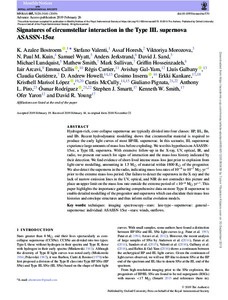Signatures of circumstellar interaction in the Type IIL supernova ASASSN-15oz
K. Azalee Bostroem; Stefano Valenti; Assaf Horesh; Viktoriya Morozova; N. Paul M. Kuin; Samuel Wyatt; Anders Jerkstrand; David J. Sand; Michael Lundquist; Mathew Smith; Mark Sullivan; Griffin Hosseinzadeh; Iair Arcavi; Emma Callis; Régis Cartier; Avishay Gal-Yam; Lluís Galbany; Claudia Gutiérrez; D. Andrew Howell; Cosimo Inserra; Erkki Kankare; Kristhell Marisol López; Curtis McCully; Giuliano Pignata; Anthony L. Piro; Ósmar Rodríguez; Stephen J. Smartt; Kenneth W. Smith; Ofer Yaron; David R. Young
Signatures of circumstellar interaction in the Type IIL supernova ASASSN-15oz
K. Azalee Bostroem
Stefano Valenti
Assaf Horesh
Viktoriya Morozova
N. Paul M. Kuin
Samuel Wyatt
Anders Jerkstrand
David J. Sand
Michael Lundquist
Mathew Smith
Mark Sullivan
Griffin Hosseinzadeh
Iair Arcavi
Emma Callis
Régis Cartier
Avishay Gal-Yam
Lluís Galbany
Claudia Gutiérrez
D. Andrew Howell
Cosimo Inserra
Erkki Kankare
Kristhell Marisol López
Curtis McCully
Giuliano Pignata
Anthony L. Piro
Ósmar Rodríguez
Stephen J. Smartt
Kenneth W. Smith
Ofer Yaron
David R. Young
OXFORD UNIV PRESS
Julkaisun pysyvä osoite on:
https://urn.fi/URN:NBN:fi-fe2021042822457
https://urn.fi/URN:NBN:fi-fe2021042822457
Tiivistelmä
Hydrogen-rich, core-collapse supernovae are typically divided into four classes: IIP, IIL, IIn, and IIb. Recent hydrodynamic modelling shows that circumstellar material is required to produce the early light curves of most IIP/IIL supernovae. In this scenario, IIL supernovae experience large amounts of mass-loss before exploding. We test this hypothesis on ASASSN-15oz, a Type IIL supernova. With extensive follow-up in the X-ray, UV, optical, IR, and radio, we present our search for signs of interaction and the mass-loss history indicated by their detection. We find evidence of short-lived intense mass-loss just prior to explosion from light-curve modelling, amounting in 1.5 M-circle dot of material within 1800 R-circle dot of the progenitor. We also detect the supernova in the radio, indicating mass-loss rates of 10(-6) to 10(-7) M-circle dot yr(-1) prior to the extreme mass-loss period. Our failure to detect the supernova in the X-ray and the lack of narrow emission lines in the UV, optical, and NIR do not contradict this picture and place an upper limit on the mass-loss rate outside the extreme period of <10(-4) M-circle dot yr(-1). This paper highlights the importance gathering comprehensive data on more Type II supernovae to enable detailed modelling of the progenitor and supernova which can elucidate their mass-loss histories and envelope structures and thus inform stellar evolution models.
Kokoelmat
- Rinnakkaistallenteet [27094]
